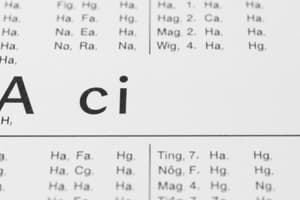Podcast
Questions and Answers
What is the primary criterion for selecting the parent chain within a complex substituent?
What is the primary criterion for selecting the parent chain within a complex substituent?
- The shortest continuous chain in the substituent.
- The carbon chain with the most functional groups.
- The longest continuous carbon chain, including the attachment point. (correct)
- The chain with the fewest number of carbon atoms.
In numbering a substituent chain, what is the key objective?
In numbering a substituent chain, what is the key objective?
- To maximize the sum of the substituent numbers.
- To give all substituents the highest possible number.
- To assign the lowest possible numbers to all substituents. (correct)
- To give parent chain carbons the lowest numbers.
When is it necessary to use prefixes like 'di-', 'tri-', 'tetra-' within the name of a complex substituent?
When is it necessary to use prefixes like 'di-', 'tri-', 'tetra-' within the name of a complex substituent?
- When multiple instances of the same substituent are present on the substituent. (correct)
- When the substituent has a chain of 3 or more carbons.
- When different functional groups are attached to a carbon within the substituent.
- Only when there are multiple different substituents within the same chain.
What is the purpose of using parentheses in the name of a complex substituent, like in 2-(1-methylethyl)hexane?
What is the purpose of using parentheses in the name of a complex substituent, like in 2-(1-methylethyl)hexane?
How should functional groups within a complex substituent be prioritized when numbering the substituent chain?
How should functional groups within a complex substituent be prioritized when numbering the substituent chain?
What functional group is indicated by the suffix '-oxy' when naming a complex substituent?
What functional group is indicated by the suffix '-oxy' when naming a complex substituent?
When naming a cyclic substituent, how is the attachment point to the main chain numbered?
When naming a cyclic substituent, how is the attachment point to the main chain numbered?
If a substituent has multiple chains of equivalent length, how is the parent chain determined?
If a substituent has multiple chains of equivalent length, how is the parent chain determined?
What is the correct way to name a substituent that has both a ketone and an alcohol?
What is the correct way to name a substituent that has both a ketone and an alcohol?
In the name 1-(4-bromophenyl)pentan-3-one, what does the '3' indicate?
In the name 1-(4-bromophenyl)pentan-3-one, what does the '3' indicate?
Why is it important to adhere to nomenclature rules in chemical structures?
Why is it important to adhere to nomenclature rules in chemical structures?
What does the prefix '2-methylpropyl' signify?
What does the prefix '2-methylpropyl' signify?
What is the correct interpretation of the name 1,1-dimethylethyl?
What is the correct interpretation of the name 1,1-dimethylethyl?
Flashcards
2-methylpropyl
2-methylpropyl
A propyl chain with a methyl group at the second carbon.
1,1-dimethylethyl
1,1-dimethylethyl
An ethyl chain with two methyl groups at the first carbon.
Naming Substituents on Cycloalkanes
Naming Substituents on Cycloalkanes
Substituents attached to rings are named and numbered before the parent cycloalkane name is added.
Precedence Rule for Multiple Functional Groups
Precedence Rule for Multiple Functional Groups
Signup and view all the flashcards
Importance of Chemical Nomenclature
Importance of Chemical Nomenclature
Signup and view all the flashcards
Parent Chain in Substituents
Parent Chain in Substituents
Signup and view all the flashcards
Prefixes for Substituents
Prefixes for Substituents
Signup and view all the flashcards
Suffixes for Substituents
Suffixes for Substituents
Signup and view all the flashcards
Numbering Substituent Chain
Numbering Substituent Chain
Signup and view all the flashcards
Branched Substituents
Branched Substituents
Signup and view all the flashcards
Functional Groups in Substituents
Functional Groups in Substituents
Signup and view all the flashcards
Parentheses in Substituent Names
Parentheses in Substituent Names
Signup and view all the flashcards
Naming Cyclic Substituents
Naming Cyclic Substituents
Signup and view all the flashcards
Study Notes
Introduction to Naming Complex Substituents
- Naming complex substituents follows specific rules for unambiguous identification in chemical nomenclature.
- These rules are crucial for accurate communication and understanding of chemical structures.
Prefixes and Suffixes
- Complex substituents use prefixes and suffixes to denote multiple carbon atoms or functional groups.
- Prefixes (methyl-, ethyl-, propyl-) indicate the number and type of carbon atoms.
- Suffixes (-yl, -oxy) specify functional groups attached to the chain.
Identifying the Parent Chain
- The longest continuous carbon chain in the substituent is the parent name and must include the attachment point to the main molecule.
- If multiple chains of equal length are possible, the chain with more substituents is chosen.
Numbering the Substituent Chain
- Carbon atom numbering in the substituent is critical.
- Numbers are assigned to give substituents the lowest possible numbers.
Naming Branched Substituents
- Substituents on the parent chain are named as alkyl groups (methyl, ethyl, propyl, etc.).
- The carbon atom bearing the substituent is numbered.
- Prefixes (di-, tri-, tetra-) indicate multiple identical substituents.
Naming Functional Groups within Complex Substituents
- Functional groups within the substituent are named following chemical nomenclature rules.
- Examples include halogens (fluoro, chloro, bromo, iodo), alcohols (-ol), ethers (-oxy), ketones (one), aldehydes (al), and amines.
- Functional group placement is numbered using the same rule as alkyl chain numbering (lowest possible numbers for substituents).
Parentheses in Substituent Names
- Parentheses enclose the name of complex substituents to distinguish them from the main molecule.
- Example: 2-(1-methylethyl)hexane shows the substituent is a 1-methylethyl group.
Naming Cyclic Substituents
- Cyclic substituents are cycloalkane rings.
- Ring numbering prioritizes the lowest number for the attachment point to the main chain.
- Substituents on the cyclic substituent are named and numbered, then the parent cycloalkane name is added.
Rules for Multiple Functional Groups
- If a substituent has multiple functional groups (e.g., ketone and alcohol), the group with precedence (per nomenclature rules) is given the lowest possible number.
Examples of Substituent Naming
- 2-methylpropyl: A propyl chain with a methyl group at the second carbon.
- 1,1-dimethylethyl: An ethyl chain with two methyl groups at the first carbon.
- 1-(4-bromophenyl)pentan-3-one: A pentan-3-one chain with a 4-bromophenyl group at the first carbon.
Importance of Clarity and Precision
- Applying these rules ensures accuracy in describing chemical structures for clear scientific communication.
- Consistent nomenclature promotes seamless communication and avoids misunderstandings in chemical research and development.
Studying That Suits You
Use AI to generate personalized quizzes and flashcards to suit your learning preferences.




